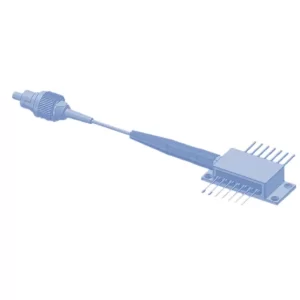What is a 14-Pin Laser Module?
14-pin laser modules – often in a butterfly package – are a staple in fiber-optic communications. They are compact, hermetically sealed metal packages with 14 electrical pins arranged in two rows (hence the name). Inside, a laser diode (usually a DFB – distributed feedback – or similar semiconductor laser) is combined with support components like a thermoelectric cooler and monitor photodiode. The module’s design ensures the laser emits a stable light signal into an optical fiber pigtail (typically already attached and ending in a fiber connector). By stabilizing temperature and feedback, 14-pin modules maintain consistent wavelength and power output, which is crucial for applications from high-speed digital links to analog fiber-optic transmissions. In essence, a 14-pin module is a self-contained laser transmitter that can be integrated into telecom equipment, cable TV systems, or optical test instruments with minimal additional engineering. Its standardized form factor and pin assignments make it easier for engineers to design driver circuits and mounting sockets, and the hermetic sealing protects the sensitive laser chip from the environment for long-term reliability (meeting Telcordia GR-468 qualifications in telecom-grade units).
Internal Structure and Key Components
To achieve stable performance, a 14-pin laser module typically contains several critical components working in unison:
- Laser Diode: The core light source, often a DFB or DBR laser chip, chosen for single-frequency operation (narrow linewidth) and the ability to be modulated at high speeds. It’s usually mounted on a submount inside the package.
- Thermoelectric Cooler (TEC): A Peltier cooler element that actively heats or cools the laser chip to maintain a constant temperature. By stabilizing temperature, the TEC ensures the laser’s wavelength remains precise (important for DWDM channels) and output power is stable over ambient temperature fluctuations.
- Thermistor: A tiny temperature sensor placed near the laser. It provides feedback to a temperature control circuit. The controller drives the TEC based on the thermistor reading, locking the laser temperature to a set-point (often around 25 °C) for optimal performance.
- Monitor Photodiode (PD): Typically positioned to receive a faint reflection of the laser’s light (often from the rear facet of the laser diode). This photodiode monitors the laser’s output power. Its current is used in a feedback loop to regulate the laser drive current, ensuring output power stays constant over time (compensating for laser aging or environmental changes).
- Optical Isolator: Many 14-pin modules, especially those for analog or coherent applications, include a miniaturized optical isolator in the light path. The isolator is a non-reciprocal optic that lets the laser light exit toward the fiber but blocks reflections coming back in. This protects the laser from optical feedback that could destabilize its frequency or increase noise. For instance, the inclusion of an isolator (often a double-stage isolator for extra protection) helps maintain ultra-low noise and prevents mode hopping.
- Fiber Pigtail: The module’s output is coupled into an optical fiber pigtail that is permanently attached inside. The fiber (single-mode, or polarization-maintaining (PM) fiber if required) routes the laser output out of the package. The free end of the pigtail is typically terminated with a standard connector (like FC/APC or LC) for easy connection to other fiber systems. The coupling optics inside the module (tiny lenses or mirrors) align the laser output into the fiber with high efficiency.
All these components are encased in a metal butterfly-shaped housing, with gold-plated pins feeding through the sides to connect the laser diode, TEC, thermistor, PD, etc., to external electronics. The pin configuration is standardized: for example, certain pins supply the TEC power, others connect to the laser anode/cathode (often with a 50 Ω RF input for modulation), and others to the photodiode and thermistor. When properly biased and controlled by external driver circuits (for current and temperature), the 14-pin module will emit a stable laser beam through the fiber pigtail at the desired wavelength and power. The result is a turnkey optical source that an engineer can use as a building block in larger systems, rather than having to assemble bare laser chips and coolers themselves.
Applications of 14-Pin Laser Modules
Because of their stability and integrated design, 14-pin laser modules see use in a wide range of photonics applications:
- Telecommunications (DWDM Networks): The telecom industry relies heavily on 14-pin DFB laser modules for Dense Wavelength Division Multiplexing. In DWDM systems, many lasers of different precise wavelengths (on the ITU grid) send data through a single fiber. A cooled 14-pin module can maintain the required wavelength accuracy (within picometers) over time. For example, a C-band DWDM laser in a 14-pin package might be set to emit at 1550.12 nm and hold that wavelength ±0.1 nm over years. These modules often operate at 2.5 Gbps, 10 Gbps, or higher data rates when directly modulated, or serve as continuous-wave sources for external modulators. Telecom lasers in this format are key for long-haul fiber links and metro networks, where their integrated TEC and monitor ensure compliance with tight channel spacing and power standards.
- Cable Television (CATV) and Analog Fiber Links: Cable TV head-ends use high-power, low-noise 1550 nm DFB lasers to transmit dozens of analog TV channels over fiber to neighborhood nodes. 14-pin analog CATV lasers are designed for linearity and low noise, since any laser noise or distortion would directly affect the TV signal quality. These are typically directly modulated by a broad composite analog signal (45–1000 MHz band carrying many TV channels). A module like Lontenoe’s JJ1782 is designed for CATV, delivering up to 40–100 mW of optical power with very low Relative Intensity Noise (RIN) and high stability. The high power allows driving long fiber spans or multiple splits without requiring an optical amplifier in some cases. Competing products from industry leaders similarly target 10–20 mW (and up to ~50 mW in some cases) with RIN around -155 dB/Hz to ensure high Carrier-to-Noise ratios. In these analog applications, the 14-pin module’s built-in isolator and TEC are vital: the isolator prevents reflections from causing composite second-order (CSO) and third-order (CTB) distortions, and the TEC keeps the laser bias optimal to minimize noise and nonlinearity.
- RF over Fiber (RFoF) and 5G Fronthaul: Beyond cable video, many modern systems send radio-frequency signals over fiber. This can include cellular networks (sending digitized or analog radio signals from a baseband unit to remote antennas) and satcom or radar signal distribution. 14-pin laser modules originally developed for analog modulation are well-suited here. For instance, the Lontenoe JJ1003 is a high-speed directly modulated laser aimed at RF-over-fiber links for 5G wireless networks. It supports modulation bandwidths up to ~6 GHz, covering the range of most sub-6 GHz 5G and WiFi radio carriers. By using such a laser at a centralized location, one can transmit an RF signal to a remote antenna with low loss and immunity to electromagnetic interference (a big advantage of fiber). The narrow linewidth (<10 MHz) and low RIN (-160 dB/Hz) of these modules ensure that even when carrying analog RF signals, the signal integrity (phase noise, error vector magnitude, etc.) remains excellent. In 5G fronthaul specifically, analog RoF can simplify the network by avoiding the need for complex baseband processing at the antenna site – the 14-pin laser directly converts the RF electrical signal into an optical signal that can be sent kilometers away instantaneously.
- Free-Space Optical Links and Sensors: Some 14-pin modules are employed in free-space optical communication systems (line-of-sight laser links between buildings or vehicles) and in optical sensing. High optical power and stable frequency are desirable here. For example, the JJ1782’s ability to emit up to 40–100 mW in the 1550 nm band with high stability makes it useful for free-space optics where atmospheric losses need to be overcome. Likewise, fiber-optic sensor systems (like interferometric hydrophones or fiber gyroscopes) often use narrow-linewidth DFB lasers in 14-pin packages as the light source. Their built-in stabilization components help maintain coherence length and avoid drift in sensor measurements. Some modules even come with polarization-maintaining fiber output to support sensors that require a polarized source.
In summary, whenever a stable, turn-key laser source is needed – whether for pumping an optical amplifier, driving an analog link, or serving as a telecom transmitter – the 14-pin butterfly module is a go-to solution in the industry. Now, let’s explore how one company’s offerings in this space (Lontenoe’s modules) compare with those from established leaders like II-VI (Coherent), Lumentum, and Finisar.
Comparing Lontenoe’s 14-Pin Modules with Industry Leaders
Lontenoe, a newer entrant in optoelectronics, has developed 14-pin laser modules (notably the JJ1003 and JJ1782 series) that target high-performance niches of fiber optics. To understand their standing, it’s useful to compare them with similar modules from well-known brands:
Leading Brands’ Background: Industry giants such as II-VI/Finisar and Lumentum (formerly JDS Uniphase) have decades of experience manufacturing laser modules. Their products are widely used in telecom networks and advanced optics. Generally, these companies provide a broad selection of 14-pin lasers, from moderate-power DWDM sources for digital communications to specialized analog CATV lasers. Many of their modules adhere to telecom standards and emphasize proven reliability (Telcordia-qualified lifetimes, strict burn-in, etc.). For example, a Lumentum or II-VI DFB laser module for DWDM might output around 10 mW of power with a linewidth of a few MHz and RIN around -155 dB/Hz – sufficient for most long-haul systems. These baseline specs ensure that big-brand modules meet the needs of typical fiber links. However, newer applications (like 5G RF-over-fiber or ultra-long reach analog links) are pushing performance needs further, and this is where Lontenoe aims to differentiate.
Performance Metrics: Power, Noise, and Bandwidth
Optical Power: One clear difference lies in output power. Lontenoe’s JJ1782 is notable for offering very high output levels – versions of this module provide 40 mW, 50 mW, 63 mW, even up to 100 mW of optical power at 1550 nm. This is on the upper end for a directly modulated DFB in a butterfly package. In contrast, many standard telecom-grade DFB modules from established brands output on the order of 10–20 mW (which has been a typical level for 10 Gb/s DWDM lasers). While there are also high-power models from big manufacturers (some specialized analog lasers or pump lasers can reach 50–100 mW), Lontenoe is clearly prioritizing high power in the JJ1782 to cater to applications like CATV where extra power can translate to better signal distribution or a higher optical budget. By delivering such power without an external optical amplifier, Lontenoe’s module simplifies system design for customers who need strong optical signals.
Noise (RIN): Relative Intensity Noise is critical for analog and coherent applications. Lontenoe’s specs are impressive: the JJ1003 14-pin laser quotes RIN around **-160 dB/Hz**, and the high-power JJ1782 remains around -155 dB/Hz despite its higher output. These figures indicate extremely low fluctuations in output intensity – a key factor for analog link performance (lower RIN means a higher signal-to-noise ratio at the receiver). Top-tier competitors also design for low RIN; for instance, many analog DFB lasers from firms like Emcore or Finisar achieve roughly -155 dB/Hz in the CATV band. Lontenoe’s -160 dB/Hz claim for JJ1003 is at the cutting edge, approaching the fundamental shot-noise limit of lasers. In fact, specialized ultra-low noise designs in the industry (using tricks like eliminating relaxation oscillations) have achieved RIN on the order of –165 to -168 dB/Hz, essentially making the laser’s intensity noise negligible compared to fundamental physics limits. Lontenoe’s devices are within ~5–10 dB of that frontier, which is to say very low noise. This gives them a competitive stance for analog RF and sensor uses. Competing modules from Lumentum or II-VI targeted at analog might list RIN in the -155 dB range as well; the difference of a few dB in RIN could be significant for certain high-dynamic-range links, and Lontenoe appears to be focusing on squeezing out as much noise as possible (for example, by including a double isolator and maintaining stable bias via their integrated PD feedback).
Bandwidth: Another differentiator is modulation bandwidth. Traditional directly modulated DFB lasers for analog use (like those in cable networks) often have bandwidths around 1–2 GHz, since CATV signals go up to ~1.2 GHz. Lontenoe’s JJ1782, in line with that, supports analog modulation up to about 2 GHz – perfectly adequate for CATV and many sensor systems. However, the JJ1003 module is designed for much faster modulation, with an option for up to 6 GHz bandwidth. This high bandwidth is relatively uncommon for directly modulated DFB lasers in 14-pin packages. Leading brands do offer high-speed DFBs (for example, lasers used in 10 Gb/s Ethernet have ~7–10 GHz bandwidth, and 25 Gb/s DMLs have ~20 GHz, but those are usually in smaller TOSA packages and aimed at digital on-off keying). Lontenoe packaging a >5 GHz analog-capable laser suggests they target emerging needs like multi-GHz RF over fiber and possibly new wireless bands. Competing solutions for >6 GHz analog links might involve using external modulators (like LiNbO₃ modulators with a CW laser) or very specialized microwave lasers. By providing 6 GHz in a convenient DFB module, Lontenoe’s JJ1003 can directly handle, say, a full C-band satcom RF feed or a 5G mid-band signal without external modulation. Big-name competitors have analogous high-speed lasers (e.g., Finisar and II-VI have DFB lasers for 25G signals), but those might not emphasize analog linearity. In summary, Lontenoe marries wide bandwidth with low noise, whereas historically one might choose either a high-bandwidth digital laser (with higher RIN) or a low-noise analog laser (with limited bandwidth). This could give Lontenoe an edge in niche applications like broadband analog photonic links.
Availability and Configuration Flexibility
When it comes to product availability and configurability, there are some practical differences. Major vendors like II-VI/Finisar and Lumentum sell 14-pin lasers primarily to equipment manufacturers. Their product lines are extensive but also standardized – one can usually get standard ITU wavelengths, standard connector options, etc., but special customizations often require large orders. Lontenoe, by contrast, appears to offer a bit more flexibility for customers in configuring modules to specific needs, likely as part of their value proposition as a smaller player. For instance, Lontenoe’s ordering information for the JJ1003 series shows options for 1310 nm or 1550 nm, various CWDM/DWDM wavelength choices, and even different bandwidth grades (a 3 GHz version and a 6 GHz version) under slightly different part numbers. They also offer choices in fiber connectorization (e.g., FC/APC connectors) and fiber type – including polarization-maintaining (PM) fiber on the JJ1782 models for applications that need stable polarization. This kind of one-stop flexibility (different wavelengths, powers, fiber types, connectors, and bandwidths to order) means a customer can get a module “tuned” for their application without needing to do the modifications themselves.
Large competitors do have broad portfolios, but often each model is fixed in its specs – e.g., a Finisar part number might correspond to a 1550 nm 10 mW laser with SM fiber, and a different model for 1310 nm. Lontenoe’s approach of listing many variants together suggests a semi-custom manufacturing process or at least a willingness to accommodate diverse needs in small volumes. Moreover, availability in the sense of lead times and sourcing might differ: established brands’ products are sometimes only available through distributors or as part of larger system components, whereas Lontenoe’s modules can likely be ordered directly in smaller quantities (the company even lists contact forms for inquiries on these modules, indicating they work closely with customers). For an optical engineer or a niche integrator, being able to quickly get a low-noise DFB laser at a specific wavelength and power, without committing to huge volume, is an advantage Lontenoe could offer over bigger competitors. In short, Lontenoe seems to provide more bespoke configuration options, while the giants provide reliability and volume but with less customization per part number.
Suitability for Key Applications: DWDM, RFoF, and 5G
All players – Lontenoe and the big three – target the core applications of DWDM, RF-over-Fiber, and new 5G/fronthaul links, but their emphases differ slightly based on legacy and strengths:
- DWDM: Lontenoe’s modules (especially JJ1782 in C-band, and JJ1003 which has DWDM channel options) are fully DWDM-capable with built-in wavelength stabilization. They specify operation across 1530–1560 nm for the high-power model and offer DWDM ITU grid wavelengths on request. Leading brands like Lumentum and II-VI practically dominate DWDM lasers in the market – their lasers are used in the majority of telecom equipment. Those modules are known for excellent wavelength locking and meeting strict standards for optical performance (side-mode suppression, etc.). In terms of differences, Lontenoe’s high-power DWDM laser could be particularly attractive for scenarios like a DWDM link that also needs to feed a passive optical splitter or a long span (where extra power helps). Big-brand DWDM lasers typically would be amplified by EDFAs in long haul, so raw laser power wasn’t as critical; but Lontenoe offering tens of mW on a DWDM channel could simplify some setups (for instance, a direct DWDM free-space link where you can’t easily add an EDFA). Both Lontenoe and competitors provide the necessary wavelength accuracy (often within ±0.1 nm over life), so suitability for DWDM is comparable, with Lontenoe perhaps carving a niche with high power on DWDM.
- RF over Fiber (RFoF): This application benefits from low noise and sufficient bandwidth. Lontenoe explicitly markets JJ1003 for RFoF and 5G use, highlighting its low RIN and 6 GHz bandwidth. Lumentum and II-VI also have analog lasers (originally for CATV) that could be used for RFoF, but they might not explicitly name 5G in legacy datasheets. Now, as 5G rollout drives interest in fronthaul links (especially for C-RAN architectures where radio signals are carried over fiber from centralized units to remote radio heads), vendors are indeed adapting. A big player might push an integrated solution (for example, an optical transceiver module carrying digitized radio data). Lontenoe’s strategy is more direct: use analog RoF, which needs an excellent analog laser. In terms of suitability, Lontenoe’s offerings are very well-suited for RFoF: JJ1003’s ~6 GHz analog bandwidth covers up to the higher end of sub-6 GHz 5G channels, and its low noise ensures minimal added error to modulated RF signals. If we compare, say, a Finisar or II-VI DFB laser originally meant for 10 Gb/s digital links – it might have the bandwidth, but its RIN could be higher (e.g., -140 dB/Hz observed in some 20 GHz bandwidth DFBs), which isn’t ideal for directly carrying analog RF (would introduce more noise in the radio link). Thus, Lontenoe’s focus on low RIN gives it an edge for directly modulated RFoF. For 5G mmWave frequencies (tens of GHz), neither Lontenoe’s nor typical DFBs can directly modulate that high – external modulators or specialized laser designs are needed. But for the bulk of 5G (sub-6 and mid-band), these lasers are sufficient. It’s likely that as the industry moves toward next-gen wireless xHaul solutions, all manufacturers (big and small) are looking at how to deliver the required performance; Lontenoe’s current lineup suggests they are positioning themselves strongly in that niche.
- 5G Fronthaul and Next-Gen Wireless: This overlaps with RFoF, but specifically, 5G has stringent requirements for signal quality (low error vector magnitude, timing, etc.). The advantage of Lontenoe’s module here is the integrated design that already considers these factors – for instance, its narrow linewidth (<10 MHz for JJ1003) means phase noise is low, which is beneficial for modulation schemes like 64-QAM OFDM used in 5G. Leading brands can and do meet 5G needs too, often via digital optical transport (like eCPRI over fiber using conventional telecom lasers). But for those pursuing analog fronthaul (perhaps for simplicity or latency reasons), a laser like JJ1003 is almost purpose-built. We might see big companies respond with similar high-bandwidth analog laser offerings if demand grows.
In all, all the compared modules can serve telecom, CATV, and RF markets, but Lontenoe emphasizes a combination of traits (high power + low noise + wide bandwidth) in a single package, whereas historically one would select different vendor models optimized for one or the other. This multi-faceted performance can be a strong point for Lontenoe in emerging applications that don’t fall neatly into old categories.
Advantages of Lontenoe’s JJ1782 and JJ1003 Series
Bringing the comparisons together, here are the clear advantages that Lontenoe’s 14-pin laser modules showcase:
- Ultra-Low Noise: With RIN figures as low as -160 dB/Hz, Lontenoe’s lasers minimize intensity noise. This is especially beneficial for analog transmission (higher SNR in RFoF links, clearer CATV signals) and for coherent systems where laser noise can degrade performance. Low RIN extends the dynamic range and fidelity of any fiber optic link.
- High Optical Power Output: The JJ1782 series in particular offers very high output powers (40–100 mW range), far above the typical ~10 mW of standard DFB lasers. Users can leverage this high power to reach longer distances or to feed multiple downstream components (like splitters or modulators) without needing an EDFA booster. It also means potentially better optical carrier-to-noise when driving photonic systems.
- Integrated Thermal Stability: All modules include built-in TECs and thermistors, providing rock-solid thermal regulation. The ability to hold the laser at a set temperature means wavelength stability (vital for DWDM) and consistent output power over -20 to +75 °C ambient ranges. Lontenoe’s design, with an internal optical isolator as well, adds stability by blocking feedback. Together, these ensure the laser’s performance doesn’t drift, yielding high reliability in the field.
- Wide Bandwidth and Fast Modulation: The JJ1003’s support for up to 6 GHz modulation is a standout feature. It allows a single laser to be used for broadband analog signals or high-speed data without an external modulator. This versatility is advantageous for hybrid networks (carrying both analog RF and digital data) and for future-proofing – a module could potentially handle evolving wireless standards that require more bandwidth.
- Flexible Configuration Options: Lontenoe provides a range of configurations under the same product family. Users can choose wavelengths (1310 nm, 1550 nm, or specific DWDM channels), fiber types (standard single-mode or PM fiber), output power bins, connector types, and even two bandwidth grades (on JJ1003). This flexibility, combined with Lontenoe’s direct engagement through their support channels, means a customer can get a semi-custom laser module tailored to their application. It’s a one-stop solution as opposed to altering a standard part post-purchase.
- Competitive Performance in Key Applications: Thanks to the above points, Lontenoe’s modules excel in the applications they target. For DWDM telecom, they offer high power and stability; for CATV/RFoF, they offer low noise and linearity; for 5G/fronthaul, they combine bandwidth and noise performance. This well-rounded capability set gives them an edge in scenarios that demand more than the “typical” spec sheet. Users designing next-gen optical links (like a dense analog 5G distributed antenna system, or a long-reach WDM analog video link) can find in these modules a ready solution without cobbling together multiple components.
In conclusion, 14-pin laser modules are the hidden workhorses of modern optical networks, and understanding their structure helps one appreciate how they manage to deliver stable laser light for everything from Netflix streams over fiber to live 5G signals feeding remote towers. Lontenoe’s JJ1782 and JJ1003 series exemplify how innovation in this domain is still very much alive – pushing the boundaries on noise, power, and bandwidth within the same familiar form factor. While established brands bring proven track records and are deeply entrenched in deployments, Lontenoe’s offerings show that newer players can drive performance forward in meaningful ways. For tech enthusiasts and optical engineers, it’s an exciting time as these advancements in laser modules open doors to more robust and flexible optical links in the era of ubiquitous broadband and wireless connectivity. With low-RIN, high-power lasers in our toolkit, we can transmit more information further and more faithfully than ever before – truly highlighting the critical role of that tiny 14-pin package in our large communications world.






